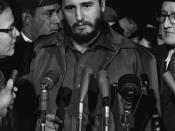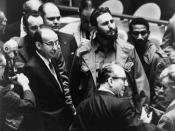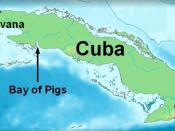Building up to the Cuban Missile Crisis, aggression occurred between the USA and Cuba for many reasons. Cuba had been in the hands of Fulgencio Batista since 1933. Batista was a military dictator and his corrupt rule caused popular discontent. Fidel Castro came into power January 1st 1959, after a brief struggle with Batista, with the help of Ernesto "Che" Guevara and nine other rebels. Castro was a brilliant propagandist and a very charismatic person. The incidents which happened between 1959 and 1961 built up tension and resulted in strong animosity.
Economically, Cuba had always been dependent on the United States. The US was exploiting them, owning most of Cuban industry, transportation, electricity production and telephone lines. 80% of Cuba's export revenue was from producing and selling sugar. Most of this sugar was grown on plantations owned by the United States and then sent to the USA. Under Batista's rule, the United States was allowed to continue with their actions but when Fidel Castro came into power in 1959, he formed a new government.
Castro wanted to make Cuba an independent country, free from US control and exploitation. He nationalized industry, impounded all foreign-owned property, and collectivized agriculture. This did not please the US government. President Dwight Eisenhower decided to stop trading arms with Cuba and eventually refused to purchase Cuban sugar in July of 1960. Castro looked to the Soviet Union for assistance. The USSR saw this as an opportunity and took advantage of the situation. The Soviets would buy Cuban sugar and in return, they would send oil, machines and money. In response to the US's action, Castro nationalized most US-owned factories and plantations. US-owned oil refineries were nationalized when they refused to take Soviet oil. Eventually, Castro severed all economic and political ties to the United States.


